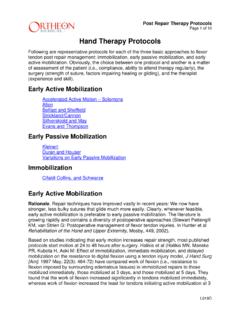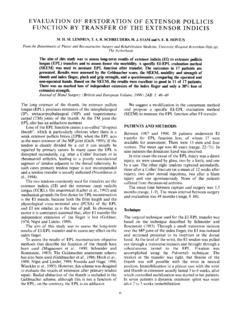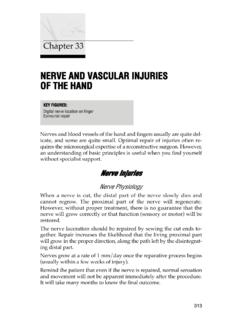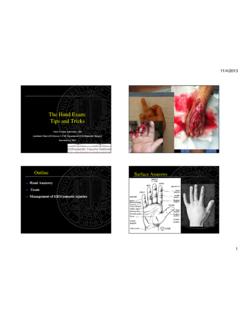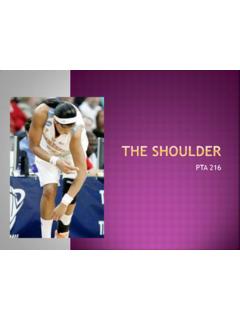Transcription of A Modification Of Elson’s Test For The ... - voor de HAND
1 A Modification Of Elson s Test For The Diagnosis Of An Acute extensor central slip InjuryA Modification Of Elson s Test For The Diagnosis Of An Acute extensor central slip InjuryTon AR Schreuders Department of Rehabilitation Medicine, Erasmus MC, University Medical Center, Rotterdam, The NetherlandsJohannes NM Soeters Department of Rehabilitation Medicine, Erasmus MC, University Medical Center, RotterdamSteven ER Hovius Department of Reconstructive and Plastic Surgery, Erasmus MC, University Medical Center, RotterdamHenk J Stam Department of Rehabilitation Medicine, Erasmus MC, University Medical Center, RotterdamWhen testing for an extensor tendon central slip lesion at the proximal interphalangeal (PIP) joint, it is proposed that the affected finger should be compared with the non-injured finger of the other hand. In this modified Elson s test, the injured finger is flexed at about 90 in the PIP joint and pushed against the dorsal side of the midphalanx of the same finger of the non-injured hand.
2 Once in this position, the patient is asked to extend the distal interphalangeal (DIP) joints. The finger with a central slip lesion will be able to extend the distal phalanx more than the non-injured distal difference between the extension at the DIP joint of the injured and non-injured hand is easily observed. Asymmetrical position of the two distal phalanges in an effort to extend the distal phalanges suggests that the central slip is not in continuity. If the two fingers remain in a symmetrical position when trying to extend the distal phalanges, a central slip lesion is highly isruption of the central slip is the most common defect leading to a traumatic boutonni re deformity. In closed injuries, acute central slip ruptures of the extensor tendon at the PIP joints can occur by two mechanisms. The most commonly encountered mechanism is forced flexion of the PIP joint, which is held actively in extension. Volar dislocation of the PIP joint is another mechanism of extensor tendon central slip rupture.
3 The characteristic boutonni re deformity is not usually present at the time of injury because extension of the PIP joint is still possible via the lateral slips of the extensor tendon. Consequently, a rupture of the central slip of the extensor tendon can easily be missed. Early diagnosis is essential to start treatment as soon as possible to prevent extensor TENDON MECHANISMThe extensor tendon mechanism of the finger is complex and is formed by contributions from tendons of both the extrinsic and intrinsic muscles. The extensor digitorum communis tendon divides distally to the metacarpophalangeal joint into the central slip , which has its insertion at the base of the mid-phalanx and two lateral bands, which merge with tendons of the intrinsic muscles to form the terminal extensor tendon inserting at the base of the distal phalanx. The lateral bands cross both the interphalangeal joints, but the central slip crosses only the PIP joint. Both the central slip and the lateral bands originate from the same tendon; consequently, the extensor tendon cannot extend the PIP joint and the DIP joint independently (Harris and Rutledge 1972).
4 extensor TENDON central slip TESTSS everal tests for the continuity of the central slip of the extensor tendon have been advocated (Boyes 1970, Elson 1986, Doyle 1993, Smith and Ross 1994). Rubin and colleagues (Rubin et al 1996) analysis of four non-invasive tests for central slip integrity, using fresh cadaver fingers, found only the Elson test reliable in the diagnosis of lost central slip function. The test suggested by Elson was, to have the injured PIP finger joint flexed in 90 over the edge of a table, and then the patient tries to extend the PIP joint against resistance. The absence of extension force at the PIP joint and fixed extension at the DIP joint are signs of complete rupture of the central slip (Elson 1986 p. 229).The biomechanical basis of Elson s test is that, in the case of a central slip lesion, it is possible to actively extend the DIP joint because the lateral bands now move independently of the central slip of the extensor tendon. The central slip is no longer attached to the middle phalanx, so pulling on the extensor tendon produces no traction on the middle phalanx, only via the lateral bands on the distal phalanx.
5 In the normal situation, the excursion of the central slip and the lateral bands are interdependent. This has been called the check-rein effect. The central slip check-reins the proximal excursion of the extensor mechanism and, therefore, has no extension effect on the distal phalanx. In other words, when the central slip is held distally by the flexed PIP joint, the lateral bands are actively insufficient to extend the DIP joint. In the case of a central slip lesion, the movements of the lateral bands are no longer restricted and will be able to extend the DIP joint in all positions of the PIP test described by Elson has two disadvantages. Firstly, estimation of the amount of extension (range of motion and strength) is difficult to interpret in one injured finger. Secondly, the inter-individual differences of finger joint mobility can also influence the extensor D The British Journal of Hand Therapy Winter 2006 Vol 11 No 4 PAGE 111A Modification Of Elson s Test For The Diagnosis Of An Acute extensor central slip injury The British Journal of Hand Therapy Winter 2006 Vol 11 No 4 PAGE 113 REFERENCESB oyes J (1970).
6 Bunnell s Surgery of the Hand, JB Lippincott, Philadelphia, J (1993). extensor Tendons Acute Injuries In: Green D (eds) Operative Hand Surgery Churchill Livingstone, New York, RA (1986). Rupture of the central slip of the extensor hood of the finger. A test for early diagnosis Journal of Bone and Joint Surgery 68- M, An KN, Berglund L, Linscheid RL, Cooney WP and Chao EY (1991). extensor mechanism of the fingers. I. A quantitative geometric study Journal of Hand Surgery 16- C and Rutledge GL (1972). The functional anatomy of the extensor mechanism of the finger Journal of Bone and Joint Surgery 54- J, Bozentka DJ and Bora FW (1996). Diagnosis of closed central slip injuries. A cadaveric analysis of non-invasive tests Journal of Hand Surgery 21-B: PJ andRoss DA (1994). The central slip tenodesis test for early diagnosis of potential boutonni re deformities Journal of Hand Surgery 19-B: 88-90. ADDRESS FOR CORRESPONDENCE:Ton AR SchreudersDepartment of Rehabilitation MedicineErasmus MC, University Medical Center Dr Molewaterplein 40, 3015 GD RotterdamThe NetherlandsTel.
7 +31 - 10 - 463 4841 Email: British Association of Hand Therapy Ltdtendon excursion and, therefore, the range of motion of the DIP joint (Garcia-Elias et al 1991). A Modification of this test is proposed, in which the active extension of the DIP joint is easily determined by testing the same fingers of both hands against each other with the PIP joint in 90o flexion (see Figures 1 and 2). The patient is asked to extend the DIP joint. In the case of a central slip lesion, the asymmetrical position of the distal phalanges is evident, whereas in a normal finger with intact central slip , active DIP extension is not possible. The proposed Modification of the Elson test has the advantage of simultaneous comparison with the contralateral digit and there is no need to test the testing for an extensor tendon central slip lesion at the PIP joint, we propose that the affected finger should be compared with the non-injured finger. In this test, the difference between the extension of the DIP joint of the injured and non-injured hand is easily observed.
8 Asymmetrical position of the distal phalanges in an effort to extend the distal phalanx suggests that the central slip is not in continuity. A Modification Of Elson s Test For The Diagnosis Of An Acute extensor central slip injury PAGE 112 The British Journal of Hand Therapy Winter 2006 Vol 11 No 4 Figure 1: The two fingers are flexed to about 90 flexion at the proximal interphalangeal joint and pushed against the middle phalanx of the same finger of the non-injured hand. The patient is asked to extend the distal interphalangeal joint. The finger with a central slip lesion will be able to extend the distal phalanx more than the non-injured phalanx. If the two fingers remain in a symmetrically flexed position, there is no central slip 2: A patient with a central slip injury of the middle finger of his right hand. When performing the extensor tendon central slip test, an asymmetrical position of the distal phalanx can easily be seen, indicating a central slip lesion of the right finger.
